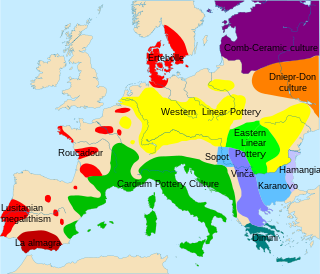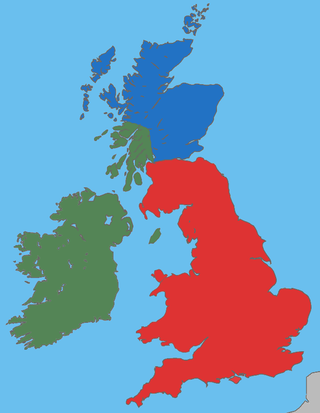Related Research Articles

North Africa is a region encompassing the northern portion of the African continent. There is no singularly accepted scope for the region, and it is sometimes defined as stretching from the Atlantic shores of the Western Sahara in the west, to Sudan's Red Sea coast in the east.

The Guanches were the indigenous inhabitants of the Canary Islands in the Atlantic Ocean some 100 kilometres (60 mi) west of the North African coast. They spoke the Guanche language, which went extinct in the 17th century and is believed to have been related to Berber languages.

Atlantic Europe is a geographical term for the western portion of Europe which borders the Atlantic Ocean. The term may refer to the idea of Atlantic Europe as a cultural unit and/or as a biogeographical region.
Genetic genealogy is the use of genealogical DNA tests, i.e., DNA profiling and DNA testing, in combination with traditional genealogical methods, to infer genetic relationships between individuals. This application of genetics came to be used by family historians in the 21st century, as DNA tests became affordable. The tests have been promoted by amateur groups, such as surname study groups or regional genealogical groups, as well as research projects such as the Genographic Project.
Bryan Clifford Sykes was a British geneticist and science writer who was a Fellow of Wolfson College and Emeritus Professor of human genetics at the University of Oxford.
The Mediterranean race is an obsolete racial classification of humans based on a now-disproven theory of biological race. According to writers of the late 19th to mid-20th centuries it was a sub-race of the Caucasian race. According to various definitions, it was said to be prevalent in the Mediterranean Basin and areas near the Mediterranean, especially in Southern Europe, North Africa, most of Western Asia, the Middle East or Near East; western Central Asia, parts of South Asia, and parts of the Horn of Africa. To a lesser extent, certain populations of people in Ireland, western parts of Great Britain, and Southern Germany, despite living far from the Mediterranean, were thought to have some minority Mediterranean elements in their population, such as Bavaria, Wales, and Cornwall.

Cardium pottery or Cardial ware is a Neolithic decorative style that gets its name from the imprinting of the clay with the heart-shaped shell of the Corculum cardissa, a member of the cockle family Cardiidae. These forms of pottery are in turn used to define the Neolithic culture which produced and spread them, commonly called the "Cardial culture".
Haplogroup V is a human mitochondrial DNA (mtDNA) haplogroup. The clade is believed to have originated over 14,000 years ago in Southern Europe.
Bob Quinn is an Irish filmmaker, writer and photographer who directed Poitín (1978), the first feature film entirely in the Irish language. His documentary work includes Atlantean, a series of four documentaries about the origins of the Irish people. Quinn has a history of protesting the commercialisation of television, resigning from RTÉ in 1969 on that basis and resigning from the RTÉ Authority in 1999 to protest toy advertising. He received a Lifetime Achievement Award from the Irish Film Institute in 2001 and is a member of the Aosdána.
Genetic studies on Sami is the genetic research that have been carried out on the Sami people. The Sami languages belong to the Uralic languages family of Eurasia.
The genetic history of the British Isles is the subject of research within the larger field of human population genetics. It has developed in parallel with DNA testing technologies capable of identifying genetic similarities and differences between both modern and ancient populations. The conclusions of population genetics regarding the British Isles in turn draw upon and contribute to the larger field of understanding the history of the human occupation of the area, complementing work in linguistics, archaeology, history and genealogy.

Sean-nós singing is unaccompanied traditional Irish vocal music usually performed in the Irish language. Sean-nós singing usually involves very long melodic phrases with highly ornamented and melismatic melodic lines, differing greatly from traditional folk singing elsewhere in Ireland, although there is significant regional variation within Ireland. Sean-nós songs cover a range of genres, from love song to lament to lullaby, traditionally with a strong focus on conveying the relevant emotion of the given song. The term sean-nós, which simply means "in the old way", is a vague term that can also refer to various other traditional activities, musical and non-musical.
Maghrebis or Maghrebians is a modern Arabic term meaning "Westerners", mainly referring to the western part of the Arab world and North Africa. Maghrebis are predominantly of Arab and Berber or mixed Arab-Berber origins.

African admixture in Europe refers to the presence of human genotypes attributable to periods of human population dispersals out of Africa in the genetic history of Europe. For example, certain Y-DNA and mtDNA lineages are thought to have spread from Northeastern Africa to the Near East during the later Pleistocene, and from there to Europe with the Neolithic Revolution.

The Insular Celts were speakers of the Insular Celtic languages in the British Isles and Brittany. The term is mostly used for the Celtic peoples of the isles up until the early Middle Ages, covering the British–Irish Iron Age, Roman Britain and Sub-Roman Britain. They included the Celtic Britons, the Picts, and the Gaels.

The genetic history of Italy is greatly influenced by geography and history. The ancestors of Italians are mostly Indo-European speakers and pre-Indo-European speakers. During the Roman empire, the city of Rome also attracted people from various regions throughout the Mediterranean basin, including Southern Europe, Tunisian and the Middle East. Based on DNA analysis, there is evidence of ancient regional genetic substructure and continuity within modern Italy dating to the pre-Roman and Roman periods.

The ancestry of modern Iberians is consistent with the geographical situation of the Iberian Peninsula in the south-west corner of Europe, showing characteristics that are largely typical in southern and western Europeans. As is the case for most of the rest of southern Europe, the principal ancestral origin of modern Iberians are Early European Farmers who arrived during the Neolithic. The large predominance of Y-Chromosome Haplogroup R1b, common throughout Western Europe, is also testimony to a sizeable input from various waves of Western Steppe Herders that originated in the Pontic-Caspian Steppe during the Bronze Age.
The genetic history of North Africa encompasses the genetic history of the people of North Africa. The most important source of gene flow to North Africa was from the Middle East, although the Sahara desert to the south and the Mediterranean Sea to the North were also important barriers to gene flow from sub-Saharan Africa and parts of Europe in prehistory. However, North Africa is connected to Western Asia via the Isthmus of Suez and the Sinai peninsula, while at the Straits of Gibraltar, North Africa and Europe are separated by only 15 km (9 mi), similarly Malta, Sicily, Canary Islands, and Crete are close to the coasts of North Africa.

Moroccan genetics encompasses the genetic history of the people of Morocco, and the genetic influence of this ancestry on world populations. It has been heavily influenced by geography.
Genetic history of the Arab world refers to the analyses of the genetics of ethnic Arab populations within the Middle East and North Africa. The Arab world has one of the highest rates of genetic disorders globally; some 906 pathologies are endemic to the Arab states, including thalassaemia, Tourette's syndrome, Wilson's disease, Charcot-Marie-Tooth disease, mitochondrial encephalomyopathies, and Niemann-Pick disease.
References
- ↑ Atlantean – WHO ARE THE IRISH? – "The Atlantean Irish" (NOW REVISED AND REPRINTED), Conemara (official Bob Quinn website)
- ↑ Bryan Sykes The Seven Daughters of Eve, pp299-308, London, 2001
- ↑ "RSAI - Book Reviews - the Atlantean Irish". Archived from the original on 13 February 2012. Retrieved 20 March 2012.
- ↑ Really Bob, have we all got a 'touch of the tar' in us?, Cathal MacCarthy, Irish Independent, Sunday September 03 2006